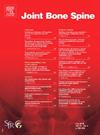亚临床趾关节炎是银屑病关节炎中较为活跃的表型。
IF 3.8
3区 医学
Q1 RHEUMATOLOGY
引用次数: 0
摘要
目的:趾关节炎是银屑病关节炎(PsA)的一个重要特征,预后较差。此外,超声波可显示亚临床趾关节炎,但其意义尚不明确。因此,本研究旨在确定亚临床趾关节炎对 PsA 严重程度的影响:研究以 PKUPsA 队列为基础。我们招募了对滑膜炎、腱鞘炎和手足软组织进行了完整超声评估的患者。根据是否存在趾关节炎的临床或超声证据,将他们进一步分为不同的亚组。对他们的临床特征进行了比较:在223名PsA患者中,有90名(40.4%)患者有趾枢关节炎的临床表现(临床趾枢关节炎组),26名(11.7%)患者有超声波显示的趾枢关节炎证据,但体格检查没有发现(亚临床趾枢关节炎组),107名(47.9%)患者既没有临床也没有超声波显示的趾枢关节炎证据(无趾枢关节炎组)。亚临床肱二头肌炎也代表了一种更活跃的 PsA 表型,需要更多的关注和更积极的治疗。本文章由计算机程序翻译,如有差异,请以英文原文为准。
Subclinical dactylitis is linked with active phenotype of psoriatic arthritis
Objective
Dactylitis has been identified as an important feature of psoriatic arthritis (PsA) with poorer prognosis. Moreover, ultrasound can reveal subclinical dactylitis, however its significance is unclear. Therefore, in this study, we aimed to determine the impact of subclinical dactylitis on PsA severity.
Methods
The study was performed based on the PKUPsA cohort. Patients with complete ultrasound assessment on synovitis, tenosynovitis, and soft tissue of both hands and feet were recruited. They were further classified into subgroups based on the presence of clinical or ultrasound evidence of dactylitis. Their clinical characteristics were compared.
Results
Among the 223 PsA patients enrolled, there were 90 (40.4%) patients with clinical manifestations of dactylitis (clinical dactylitis group), 26 (11.7%) with evidence of dactylitis on ultrasound however not on physical examination (subclinical dactylitis group), and 107 (47.9%) patients with neither clinical nor ultrasound evidence of dactylitis (no-dactylitis group). Compared with no-dactylitis group, patients in clinical dactylitis group had more swollen joint count (4 vs. 2, P < 0.01), tender joint count (4 vs. 3, P < 0.05), and greater median disease activity index in PsA (DAPSA) (25.0 vs. 18.3, P < 0.05). Moreover, 116 PsA patients in clinical dactylitis or subclinical dactylitis groups also had more tender joint count (4 vs. 2, P < 0.01), swollen joint count (4 vs 3, P < 0.001), median C-reactive protein levels (18.1 vs. 11.8, P < 0.05) and median DAPSA scores (25.5 vs. 16.1, P < 0.01). Even excluding the digits with dactylitis from counting, the swollen joint count of 116 patients with dactylitis remained significantly greater than that of no-dactylitis group (3 vs. 2, P < 0.01). 26 patients in subclinical dactylitis group also showed significantly higher DAPSA scores (27.2 vs. 16.1, P < 0.05), more swollen joint count (4.5 vs. 2, P < 0.01) and tender joint count (5 vs. 3, P < 0.05) than no-dactylitis group.
Conclusion
Subclinical dactylitis also represents a more active phenotype of PsA, which calls for more attention and probably more aggressive therapy.
求助全文
通过发布文献求助,成功后即可免费获取论文全文。
去求助
来源期刊

Joint Bone Spine
医学-风湿病学
CiteScore
4.50
自引率
11.90%
发文量
184
审稿时长
25 days
期刊介绍:
Bimonthly e-only international journal, Joint Bone Spine publishes in English original research articles and all the latest advances that deal with disorders affecting the joints, bones, and spine and, more generally, the entire field of rheumatology.
All submitted manuscripts to the journal are subjected to rigorous peer review by international experts: under no circumstances does the journal guarantee publication before the editorial board makes its final decision. (Surgical techniques and work focusing specifically on orthopedic surgery are not within the scope of the journal.)Joint Bone Spine is indexed in the main international databases and is accessible worldwide through the ScienceDirect and ClinicalKey platforms.
 求助内容:
求助内容: 应助结果提醒方式:
应助结果提醒方式:


